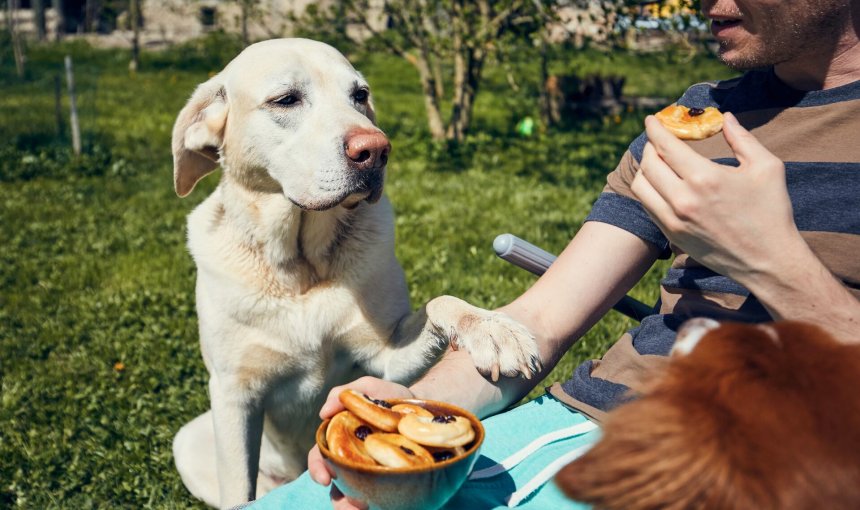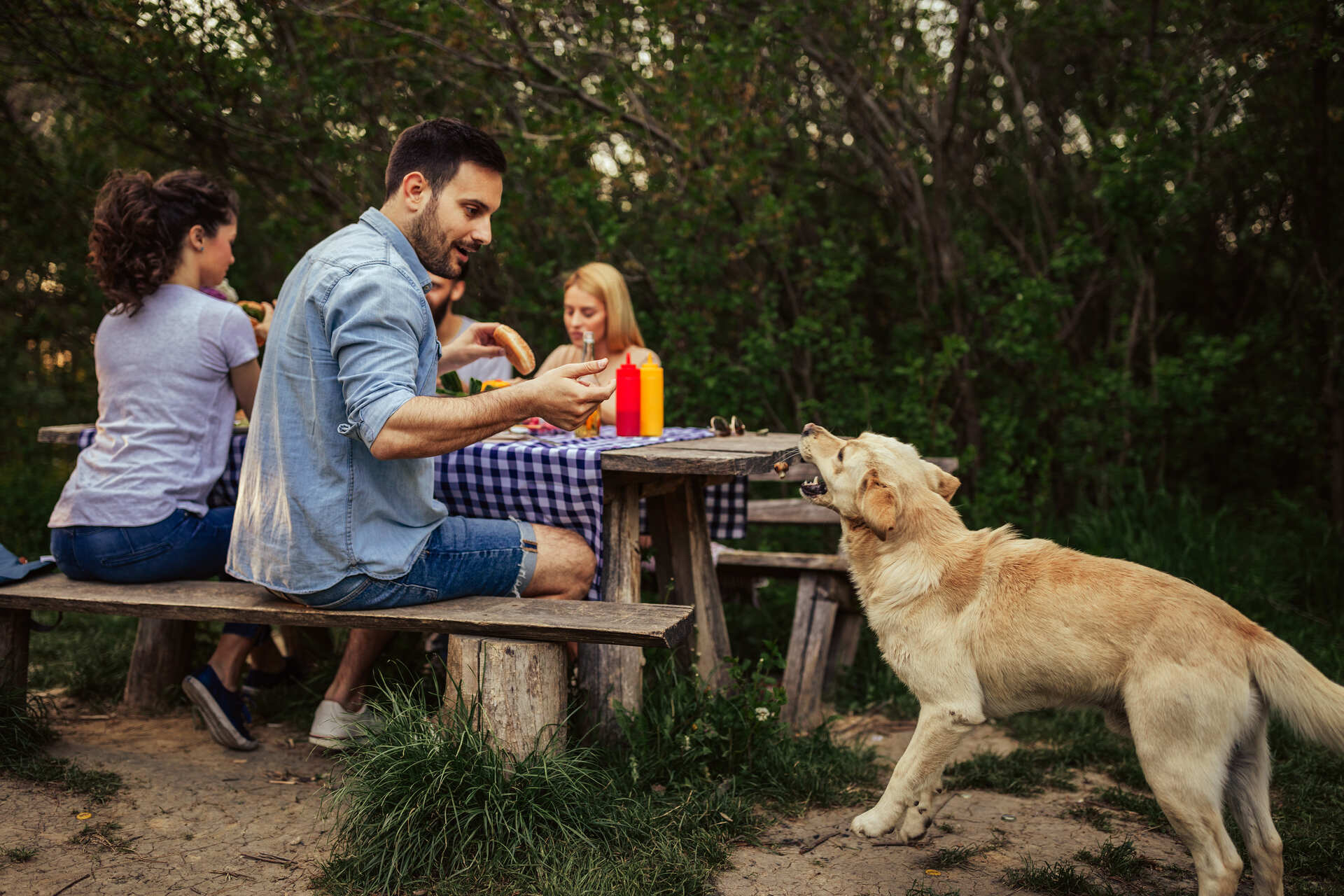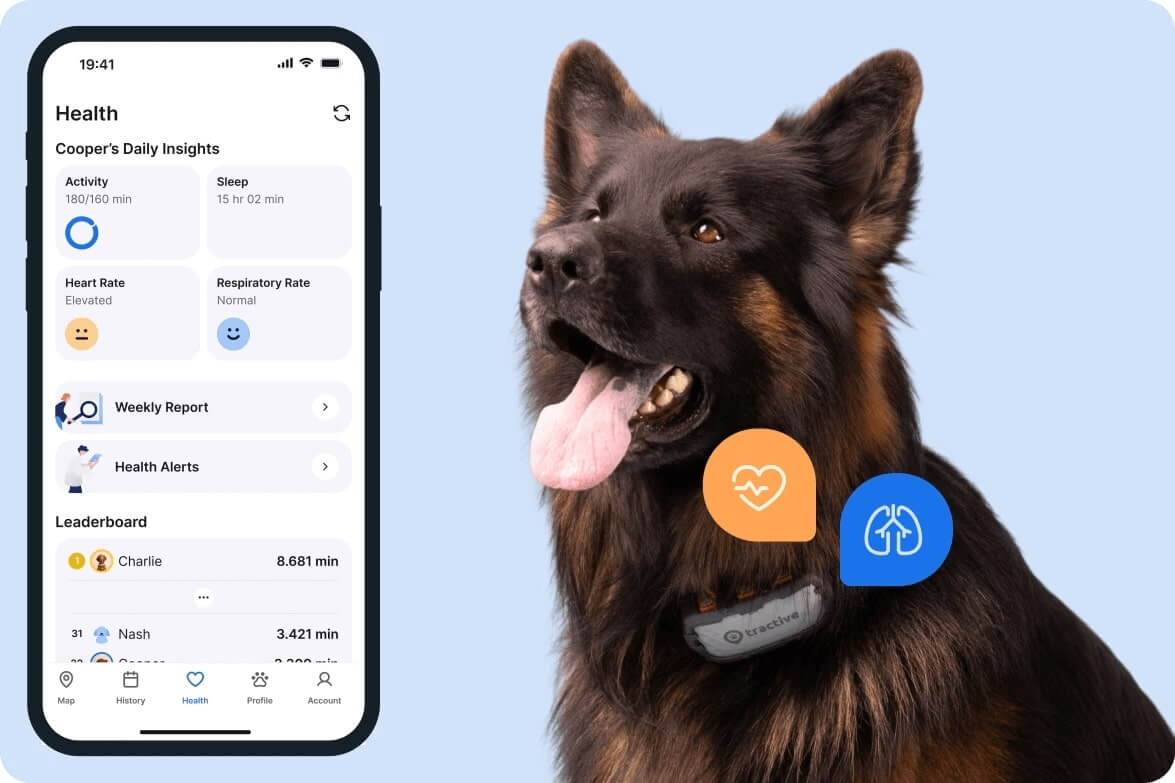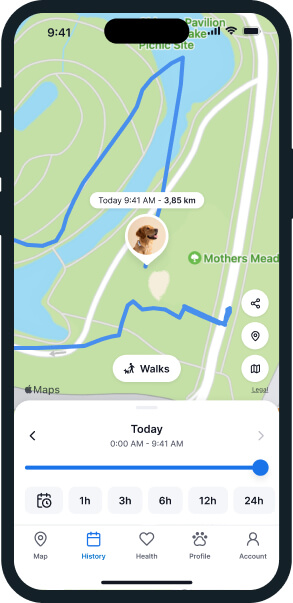Dog Begging For Food? Here’s How To Stop It For Good
Here's why they do it, what you can do to stop it & how to plan ahead for an emergency.

It can be pretty cute watching your dog begging for food – but let’s admit it, it can get annoying after a while too. Here’s why they do it – even if you’ve fed them – plus, how a smart dog tracker can help wean them off this behavior.
Key Takeaways
The best way to stop begging is to ignore your dog completely when they do it. Be consistent with a strict feeding schedule, and make sure everyone in your house knows the “no table scraps” rule.
An outdoor dog begging for food may be at risk of getting fed something potentially toxic entirely by accident. So make sure to inform your neighbors as well.
The Tractive smart dog tracker can help you keep your food-motivated dog safe and healthy. You can check the tracker’s map to see if they are wandering off to places like the local park or garbage area to look for snacks, which can help you stop them from eating something harmful.

Always know your buddy is healthy & safe
Read more- Why is my dog begging for food?
- How to stop your dog from begging for food & treats
- Follow a consistent feeding schedule
- Avoid free-feeding
- Ignore the begging
- Set some firm boundaries with your friends, family & housemates
- Never let your dog into the kitchen or dining areas unsupervised
- Keep your dog occupied elsewhere while cooking
- Don’t skip out on your dog’s training
- Keep an eye on your dog’s outdoor wanderings
- Where a smart dog tracker can prevent an emergency
Why is my dog begging for food?
Primarily, begging is a learned behavior – meaning, it’s gotten them a good outcome (aka, treats) in the past. So they’re likely to repeat it as much as they can get away with it. Your dog might also beg for food as a form of attention-seeking, or even out of boredom. In rarer cases, they could actually still be hungry.
How to stop your dog from begging for food & treats
Follow a consistent feeding schedule
And stick to it. Dogs thrive on routine and feeding them around the same time every day can help them figure out when it’s mealtime. If you’re consistent, it can gradually reduce their urge to beg outside of these times. Your vet can also help you figure out the right amount of food your buddy needs depending on their age, size, breed, activity level, and general health.
In general, most dogs do well with two sensibly-portioned meals a day – one in the morning and one in the evening. And as the weather gets warmer, it helps to ensure they’ve got access to plenty of cool water throughout the day.
Read more: How much should I feed my dog and how often?
Avoid free-feeding
I.e., don’t leave food out all day for your dog to freely access. Unless you’re there to teach them, most dogs aren’t picky eaters and some might have zero to no limits around unrestricted amounts of food. With time, this can lead to overeating, obesity, and a host of throughly avoidable – and even deadly – health problems.
Ignore the begging
So if you’ve got your dog begging for food, you have to practice not giving them any attention. Avoid making eye contact or talking to them. You could even physically turn away from your dog when they beg. If they keep at it, leave the room until they stop.
As counterintuitive as it is, interacting with or speaking to your dog in any way just means you’re giving them attention. Which, unfortunately, means your buddy will persist with the puppy eyes or making a nuisance of themselves until you give in. But by ignoring them, you can help your dog learn that “begging for food = no attention or treats.” So make sure you’re consistent – even the slightest bit of attention can get your buddy back to begging again.
Set some firm boundaries with your friends, family & housemates
It’s important to have everyone in your household on the same page regarding your buddy’s feeding schedule. You could always have a situation where one of your kids palms off some unwanted veggies to your buddy – or someone feeds them something potentially toxic, entirely by accident. So make sure to explain why it’s important not to feed your buddy any table scraps or treats outside of their designated feeding times. Gently remind guests and family members of the rules when necessary. You could even put up signs around your house as reminders of your “no extra treats” policy.
Besides your housemates, it’s smart to inform your neighbors as well. (In case your buddy has a habit of wandering over to their backyards or around your neighborhood.) Suggest alternatives, like playing with toys or giving your dog a ton of pets and praise (without food being involved.)
Finally, do keep some healthy treats at hand, like fresh vegetables that are safe for dogs to eat or some low-calorie kibble.
Read more: 10 Of The Best Vegetables For Dogs & How To Prep Them

Never let your dog into the kitchen or dining areas unsupervised
Besides begging, there’s always the chance your buddy might sneak a bite or two off your kitchen counter – or anything that might drop on the floor from the table. So it’s a good idea to monitor every morsel that ends up in their mouth, especially if you’re busy in the kitchen. Many ingredients that are harmless (and even healthy) for humans might just end up being toxic to dogs. (And land you with a hefty, thoroughly avoidable vet bill.)
💡 So stay informed on what common kitchen ingredients are off-limits for dogs – and make sure to keep your buddy well away from these. For example, besides chocolate, dogs can also be poisoned by:
- Onions
- Garlic
- Grapes
- Raisins
- Mushrooms
- …and a host of other foods.
Keep your dog occupied elsewhere while cooking
Besides supervising your buddy in the kitchen, we’d also recommend you create a separate feeding area for them. The physical separation can help reduce their temptation to beg at the “human food” table. Make sure this are is quiet and free from distractions – and that you’re feeding your buddy at regular times.
It’s also not a bad idea to keep your dog distracted while you’re busy with meal prep. Give them a puzzle toy to keep them occupied – or get one of your housemates (or kids) to play with them while you’re cooking.
Don’t skip out on your dog’s training
Teaching your dog commands like “Sit,” “Stay,” and “Drop it,” can help them learn to control their impulses and not go running behind every morsel like it’s their last meal on the planet! This might look like training your buddy to:
- Sit while you get out the food bowls,
- Stay for a few seconds after you’ve poured out the food
- Drop it, if they immediately dive into eating – or pick up a “treat” that’s fallen from the kitchen counter
- Only eat once you give the command “Eat,” – or similar
Read more: 4 Important Dog Commands & How To Teach ‘Em
Keep an eye on your dog’s outdoor wanderings
Even with all these precautions, some dogs can still wander outdoors to sniff out some extra treats or snacks. Meaning, if you don’t take steps to plan ahead for an emergency, you’re likely to find your dog begging for food and making a nuisance of themselves at picnics at your local park, camps nearby, dog parks in your neighborhood, or even outside cafes and restaurants. All places where someone might feed them something harmful – whether by accident or not.

Follow your dog anywhere
Get real-time location information, wherever they go. And find out when they try to make an escape, or just when they go somewhere they shouldn’t, with Virtual Fences.
Where a smart dog tracker can prevent an emergency
In some cases, your dog might be acting like they’re starving because they are burning a lot more energy than you think. Or maybe they’re getting secret snacks somewhere else! That’s where a Tractive smart dog tracker can help you better understand their behavior.
Strapped to your dog’s collar, you can now:
Figure out how much activity your dog’s gotten
A dog that’s constantly begging might simply need more exercise to match their diet. With its built-in motion detector, your Tractive tracker monitors how active your dog is throughout the day. You can see exactly how many minutes they spend playing, walking, and running. If you think they’re getting enough exercise but the tracker shows they are consistently low on activity, you’ll know they might need longer walks or more playtime. This data helps you match their food portions to how much energy they’ve burned, keep your dog well-fed, and put a stop to any begging.

Identify any sneaky snack spots
Sometimes your dog might be getting food from a source you don’t know about. Your tracker’s Location History shows you every place they’ve visited. The Heatmap highlights where they spend the most time. If they’re consistently stopping at a specific neighbor’s yard, a back alley, or a friend’s house, they might be getting a few extra snacks from a well-meaning person. (Or finding discarded food.) There’s your first step to stopping the unwanted feeding and correcting the begging behavior.

This way, you’ll be able to better understand your dog’s behavior, figure out why it’s happening, and put a stop to it – for good.



